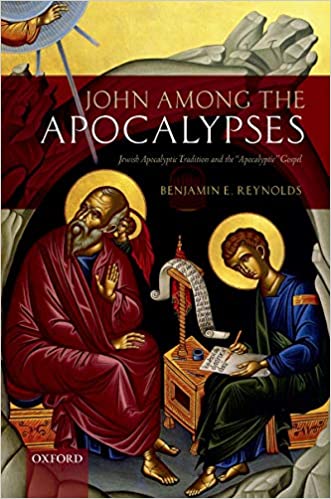File:2020 Reynolds.jpg
2020_Reynolds.jpg (331 × 499 pixels, file size: 39 KB, MIME type: image/jpeg)
{en} Benjamin E. Reynolds, John among the Apocalypses: Jewish Apocalyptic Tradition and the 'Apocalyptic' Gospel (Oxford: Oxford University Press, 2020).
Abstract
"The Gospel of John has long been recognized as being distinct from the Synoptic Gospels. John among the Apocalypses explains John's distinctive narrative of Jesus's life by comparing it to Jewish apocalypses and highlighting the central place of revelation in the Gospel. While some scholars have noted a connection between the Gospel of John and Jewish apocalypses, Reynolds makes the first extensive comparison of the Gospel with the standard definition of the apocalypse genre. Engaging with modern genre theory, this comparison indicates surprising similarities of form, content, and function between John's Gospel and Jewish apocalypses ... Even though the Gospel of John reflects similarities with the genre of apocalypse, John is not an apocalypse, but in genre theory terms, John may be described as a gospel in kind and an apocalypse in mode. John's narrative of Jesus's life has been qualified and shaped by the genre of apocalypse, such that it may be called an 'apocalyptic' gospel. In the final two chapters, Reynolds explores the implications of this conclusion for Johannine Studies and New Testament scholarship more broadly ... John among the Apocalypses considers how viewing the Fourth Gospel as apocalyptic Gospel aids in the interpretation of John's appeal to Israel's Scriptures and Mosaic authority, and examines the Gospel's relationship with the book of Revelation and the history of reception concerning their writing. An examination of Byzantine iconographic traditions highlights how reception history may offer a possible explanation for reading John as apocalyptic Gospel."--Publisher description.
Benjamin E. Reynolds is Professor of New Testament at Tyndale University in Toronto. He is author of The Apocalyptic Son of Man in the Gospel of John (Mohr Siebeck, 2008), editor of The Son of Man Problem (T&T Clark, 2018), co-editor with Loren Stuckenbruck of The Jewish Apocalyptic Tradition and the Shaping of New Testament Thought (Fortress, 2017), and co-editor with Gabriele Boccaccini of Reading the Gospel of John's Christology as Jewish Messianism: Royal, Prophetic, and Divine Messiahs (Brill, 2018).
Contents
Introduction -- Revelation in the Gospel of John -- Defining "Revelation" -- Evidence of Revelation in John -- The Background of John's Revelation -- Chapter 1: Genre, "Apocalypse," and the Gospel of John -- Genre Theory -- The Genre of "Apocalypse" -- The Gospel of John among the Apocalypses -- Chapter 2: The Manner of Revelation in Jewish Apocalypses and John; "Revelatory Literature with a Narrative Framework" -- The Medium of Revelation (1) in Jewish Apocalypses -- Visual Revelation (1.1) -- Auditory Revelation (1.2) -- Otherworldly Journeys (1.3) and Writing (1.4) -- The Medium of Revelation in John's Gospel -- Visual Revelation (1.1) in John -- Auditory Revelation (1.2) in John -- Otherworldly Journeys (3) and Writing (4) in John -- Revelation Mediated by an Otherworldly Mediator (2) in Jewish Apocalypses -- God as Otherworldly Mediator -- Revelation Mediated by an Otherworldly Mediator in John -- Revelation Mediated to a Human Recipient (3); Revelation Mediated to Human Recipients in John -- Conclusion -- Chapter 3: The Content of Revelation in Jewish Apocalypses and John -- Content: A Transcendent Reality that is Temporal -- Protology (4) -- Reviews of History (5) -- Present Salvation through Knowledge (6) -- Eschatological Crisis (7) -- Eschatological Judgment (8) -- Eschatological Salvation (9) -- John, Eschatology, and Time -- Summary -- Content: A Transcendent Reality That Is Spatial -- Otherworldly Elements (10) -- Conclusion -- Chapter 4: The Function of Revelation in Jewish Apocalypses and John -- Introduction; Function and the Semeia 14 Definition of "Apocalypse" -- The Function of Revelation -- Intended to Interpret Present, Earthly Circumstances in Light of the Supernatural World and of the Future -- The Gospel of John and Interpreting Present, Earthly Circumstances -- Intended to Influence both the Understanding and Behavior of the Audience by Means of Divine Authority -- The Gospel of John and Influencing Understanding and Behavior -- Summary -- Paraenesis (11) and Concluding Elements (12, 13) -- Paraenesis (11) -- Instructions to the Recipient (12) -- Narrative Conclusion (13) -- Conclusion; Chapter 5: John's Gospel as "Apocalyptic" Gospel -- John and the Genre of "Apocalypse" -- Why John Is Not an Apocalypse -- Differences in the Medium of Revelation (1): Visual Revelation (1.1) -- Differences in the Otherworldly Mediator (2) -- Jesus as Human Being -- Jesus as One with God -- Jesus as Content of the Revelation -- Christ as Mediator in Christian Apocalypses -- Differences in the Human Recipient (3) -- Summary -- An Apocalypse "in Reverse, Upside Down, Inside Out"? -- The Gospel of John as "Apocalyptic" Gospel -- John as Gospel -- John as "Apocalyptic" Gospel -- Conclusion
External links
File history
Click on a date/time to view the file as it appeared at that time.
| Date/Time | Thumbnail | Dimensions | User | Comment | |
|---|---|---|---|---|---|
| current | 16:43, 16 December 2021 |  | 331 × 499 (39 KB) | Gabriele Boccaccini (talk | contribs) |
You cannot overwrite this file.
File usage
There are no pages that use this file.
